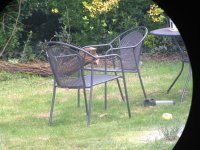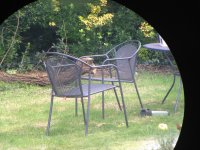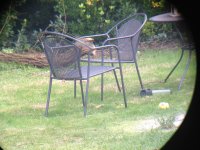Here I present the results of a quick analysis of the effect of glasses on magnification and apparent field of view.
I used a Swarovski 8.5x42 EL SV FP and an iPhone 5 mounted on tripods taking photos of the image through the binoculars with no glasses, -2.75 prescription glasses and +3.50 reading glasses. The images are attached. Measuring distances between the same points for each image taken enables a comparison of magnification using the "no glasses" image as a reference.
Results (magnification)
No glasses - 8.50x
-2.75 - 8.37x
+3.50 - 8.59x
For me where my eyes are naturally +2.75 and I need the -2.75 prescription, the base line is the -2.75 glasses and the true magnification for me is:
No glasses - 8.63x
-2.75 - 8.50x
+3.50 - 8.72x
We can also relate this somewhat to the change in apparent field of view by scaling the specified 60 degree apparent field of view by the proportional change in magnification:
Results (apparent field of view):
No glasses - 60.0 deg
-2.75 - 59.1 deg
+3.50 - 60.7 deg
For me with my +2.75 eyes making the -2.75 glasses the base line:
No glasses - 60.9 deg
-2.75 - 60.0 deg
+3.50 - 61.6 deg
Discussion
Positive prescription glasses (reading glasses) increase binocular magnification and apparent field of view and negative prescription glasses reduce magnification and apparent field of view. By removing negative prescription glasses you increase the apparent field of view and magnification slightly. If you normally don't wear glasses for distance viewing, but have some reading glasses you may find the slight increase in apparent field of view and magnification from wearing them whilst using binoculars interesting to try.
I did this little analysis because having always used glasses (-2.75) with my binoculars I recently have been taking them off more and felt the view was more immersive with a slight gain in magnification. This is born out in the results above. The changes though slight are noticeable in practice, though for practical reasons I'll probably only continue removing my glasses in stationary locations like hides or in my garden. The +3.50 reading glasses I used are low cost £5 glasses purchased to experiment with. I shan't be using these much as while the image is still useable there is a drop in quality to some aspects of the view. If you have higher quality reading glasses you may find the quality is maintained.
Hopefully some of view may find this interesting or even useful.
I used a Swarovski 8.5x42 EL SV FP and an iPhone 5 mounted on tripods taking photos of the image through the binoculars with no glasses, -2.75 prescription glasses and +3.50 reading glasses. The images are attached. Measuring distances between the same points for each image taken enables a comparison of magnification using the "no glasses" image as a reference.
Results (magnification)
No glasses - 8.50x
-2.75 - 8.37x
+3.50 - 8.59x
For me where my eyes are naturally +2.75 and I need the -2.75 prescription, the base line is the -2.75 glasses and the true magnification for me is:
No glasses - 8.63x
-2.75 - 8.50x
+3.50 - 8.72x
We can also relate this somewhat to the change in apparent field of view by scaling the specified 60 degree apparent field of view by the proportional change in magnification:
Results (apparent field of view):
No glasses - 60.0 deg
-2.75 - 59.1 deg
+3.50 - 60.7 deg
For me with my +2.75 eyes making the -2.75 glasses the base line:
No glasses - 60.9 deg
-2.75 - 60.0 deg
+3.50 - 61.6 deg
Discussion
Positive prescription glasses (reading glasses) increase binocular magnification and apparent field of view and negative prescription glasses reduce magnification and apparent field of view. By removing negative prescription glasses you increase the apparent field of view and magnification slightly. If you normally don't wear glasses for distance viewing, but have some reading glasses you may find the slight increase in apparent field of view and magnification from wearing them whilst using binoculars interesting to try.
I did this little analysis because having always used glasses (-2.75) with my binoculars I recently have been taking them off more and felt the view was more immersive with a slight gain in magnification. This is born out in the results above. The changes though slight are noticeable in practice, though for practical reasons I'll probably only continue removing my glasses in stationary locations like hides or in my garden. The +3.50 reading glasses I used are low cost £5 glasses purchased to experiment with. I shan't be using these much as while the image is still useable there is a drop in quality to some aspects of the view. If you have higher quality reading glasses you may find the quality is maintained.
Hopefully some of view may find this interesting or even useful.






